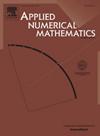Refined variational iteration method through optimal linear operator and Lagrange multiplier: Local/global convergence
IF 2.2
2区 数学
Q1 MATHEMATICS, APPLIED
引用次数: 0
Abstract
Our focus is on refining the Variational Iteration Method (VIM), which will henceforth be called R-VIM. We begin by introducing a general linear operator and consequently the Lagrange's multiplier; then, minimizing the residual error, we subsequently find the optimal linear operator as well as the best fitting Lagrange's multiplier for a given differential equation. By means of Banach Fixed Point Theorem, the necessary conditions for the convergence of the solutions of VIM, Optimal VIM, and R-VIM are established involving the Lagrange's multiplier; it has been demonstrated (and subsequently numerically certified) that solutions of VIM and Optimal VIM locally converge. While R-VIM solutions, with the aid of necessary and sufficient criteria, have been shown to converge globally for appropriate values of the unknown parameters involved in the general linear operator. We make sure that the convergence of the VIM solution depends critically on the optimal selection of the linear operator and, consequently, the best suited Lagrange's multiplier.
Our bird's eye view would be to differentiate between the contributions of the homotopy equation in homotopy-based approaches and Lagrange's multiplier-based correction functional of the VIM for the fastest convergence. Furthermore, in order to achieve fast convergence, we additionally examine if the optimal VIM's regulating parameter offers any further benefit above proposed R-VIM. We aim to apply R-VIM to problems with multiple solutions to ensure that all solutions are accurately identified. Our proposed method has been proven superior and more widely applicable through both theoretical and numerical illustrations. However, it also has its limits. Hence, we suggest the implementation of the multistep R-VIM, referred to as MR-VIM, as a means to solve chaotic dynamical systems.
通过最优线性算子和拉格朗日乘子的改进变分迭代方法:局部/全局收敛
我们的重点是改进变分迭代法(VIM),今后将称为R-VIM。我们首先引入一个一般的线性算子,然后引入拉格朗日乘子;然后,最小化残差,我们随后找到给定微分方程的最优线性算子以及最佳拟合拉格朗日乘子。利用Banach不动点定理,建立了涉及拉格朗日乘子的VIM、最优VIM和R-VIM解收敛的必要条件;证明了VIM和最优VIM的解是局部收敛的(并随后进行了数值证明)。而R-VIM解在必要和充分准则的帮助下,对于一般线性算子所涉及的未知参数的适当值,已被证明是全局收敛的。我们确保VIM解的收敛性主要取决于线性算子的最优选择,因此,最适合的拉格朗日乘子。我们的鸟瞰图将区分基于同伦的方法中同伦方程的贡献和基于拉格朗日乘数的修正函数的VIM的最快收敛。此外,为了实现快速收敛,我们还研究了最优VIM的调节参数是否提供了上述R-VIM的任何进一步的好处。我们的目标是将R-VIM应用于具有多种解决方案的问题,以确保准确识别所有解决方案。理论和数值实例均证明了该方法的优越性和广泛的适用性。然而,它也有其局限性。因此,我们建议实现多步R-VIM,简称MR-VIM,作为求解混沌动力系统的一种手段。
本文章由计算机程序翻译,如有差异,请以英文原文为准。
求助全文
约1分钟内获得全文
求助全文
来源期刊

Applied Numerical Mathematics
数学-应用数学
CiteScore
5.60
自引率
7.10%
发文量
225
审稿时长
7.2 months
期刊介绍:
The purpose of the journal is to provide a forum for the publication of high quality research and tutorial papers in computational mathematics. In addition to the traditional issues and problems in numerical analysis, the journal also publishes papers describing relevant applications in such fields as physics, fluid dynamics, engineering and other branches of applied science with a computational mathematics component. The journal strives to be flexible in the type of papers it publishes and their format. Equally desirable are:
(i) Full papers, which should be complete and relatively self-contained original contributions with an introduction that can be understood by the broad computational mathematics community. Both rigorous and heuristic styles are acceptable. Of particular interest are papers about new areas of research, in which other than strictly mathematical arguments may be important in establishing a basis for further developments.
(ii) Tutorial review papers, covering some of the important issues in Numerical Mathematics, Scientific Computing and their Applications. The journal will occasionally publish contributions which are larger than the usual format for regular papers.
(iii) Short notes, which present specific new results and techniques in a brief communication.
 求助内容:
求助内容: 应助结果提醒方式:
应助结果提醒方式:


